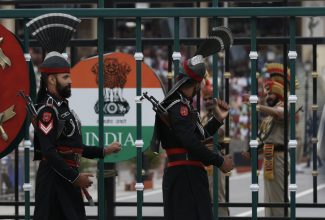Massacre in the Meadow: Kashmir’s worst civilian attack in years shakes the region’s fragile calm

By Gunjeet Sra
NEW DELHI: It was meant to be a quiet escape — a trip through one of the most picturesque corners of the Himalayas, where rolling meadows and crisp mountain air draw thousands each year. Instead, it turned into a nightmare.
On April 22, gunmen opened fire on a group of tourists in Jammu and Kashmir’s remote Pahalgam region, killing 26 people and wounding more than a dozen others in one of the deadliest attacks on civilians the region has seen in years.
The assault unfolded in the Baisaran Valley, a secluded stretch of land accessible only by foot or horseback, nestled in the forested hills of the Anantnag district. Among the dead was 29-year-old Syed Adil Hussain Shah, a local pony handler who reportedly died trying to disarm one of the gunmen — the only Kashmiri among the victims. The rest were mostly Indian tourists, along with one Nepali national and an Indian-origin man based in the Middle East.
Survivors described a horrifying scene. Witnesses said the assailants fired from close range, allegedly separating men and demanding they recite Islamic verses — a crude religious test meant to identify Hindu tourists. Local villagers rushed in, carrying the injured down the mountainside using makeshift stretchers and ponies.
Responsibility was claimed online by The Resistance Front (TRF), a banned militant group with known ties to Lashkar-e-Taiba (LeT), a Pakistan-based terrorist organization. TRF emerged after the Indian government revoked Article 370 in 2019, stripping Jammu and Kashmir of its special constitutional status. Since then, the group has become notorious for attacks on security forces and civilians alike.
In 2023, India formally designated TRF a terrorist organization under the Unlawful Activities (Prevention) Act, citing its involvement in cross-border militancy and destabilization efforts in the Valley. Security agencies say TRF acts as a front for Lashkar, allowing the latter plausible deniability while continuing to wage its proxy war.
Sources also revealed that investigators are probing the possible role of Saifullah Kasuri, also known as Saifullah Khalid — a senior LeT commander believed to be a close aide of Hafiz Saeed, the mastermind of the 2008 Mumbai attacks. Kasuri has allegedly orchestrated numerous terror strikes over the past two decades.
Officials believe the assailants have now escaped to the higher elevations of the Pir Panjal mountain range. The Indian Army, central paramilitary forces, and Jammu and Kashmir Police have launched an extensive manhunt in the area.
A Symbolic Strike
The attack comes at a deeply symbolic moment for the region. In the coming weeks, Prime Minister Narendra Modi is scheduled to inaugurate a long-awaited railway line connecting the Kashmir Valley to the rest of India. The Udhampur-Srinagar-Baramulla Railway Line (USBRL) — a project decades in the making — is touted as a “lifeline” for the region’s economy and tourism sector.
Isolated for decades due to treacherous terrain and political strife, Kashmir’s economic potential has long gone unrealized. Now, officials hope the USBRL will usher in a new era of accessibility and development. But this bloodshed — especially targeting Hindu tourists near a key route of the annual Amarnath Yatra — casts a long shadow over that promise.
The fate of this year’s pilgrimage remains uncertain.
Condemnation and Fallout
Public grief has erupted across the region. Candlelight vigils were held in Srinagar, with signs reading “Stop terrorism.” Airlines quickly added extra flights to evacuate tourists. Prime Minister Modi, who cut short an official trip to Saudi Arabia, posted on X (formerly Twitter): “Those behind this heinous act will not be spared. Their evil agenda will never succeed.”
In an emergency briefing, Indian Foreign Secretary Vikram Misri blamed cross-border terrorism, suggesting Pakistani complicity. Pakistan’s Foreign Office responded with a strong denial, calling the violence “tragic” but denying any involvement.
India’s retaliatory steps were swift and severe. The Indus Waters Treaty , signed in 1960 with the mediation of the World Bank, allocates water rights between India and Pakistan for the use of the Indus River system. Under the treaty, India controls the waters of the eastern rivers—Ravi, Beas, and Sutlej—while Pakistan has rights to the western rivers—Indus, Jhelum, and Chenab.
Despite decades of tension, the treaty has largely endured as a rare example of cooperation between the two nations. Late last evening, India suspended the treaty. SAARC visa exemptions for Pakistani nationals were also revoked. All Pakistani citizens in India were ordered to leave within 48 hours. Trade at the Attari border crossing was suspended, and military attaches from both countries were recalled.
Meanwhile, Home Minister Amit Shah chaired a high-level security meeting in Srinagar. Defense Minister Rajnath Singh condemned the attack as “religiously targeted” and “cowardly.”




